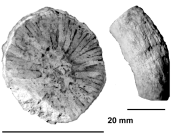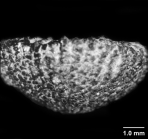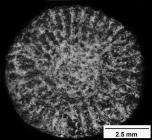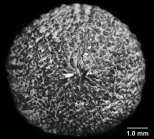Scleractinia taxon details
Palaeopsammia Wanner, 1902 †
1439900 (urn:lsid:marinespecies.org:taxname:1439900)
accepted
Genus
Palaeopsammia multiformis Wanner, 1902 † (type by subsequent designation)
Diegosmilia Alloiteau, 1958 † · unaccepted > junior subjective synonym
Kumbiopsammia Alloiteau, 1958 † · unaccepted > junior subjective synonym
Pachycyathus Alloiteau, 1958 † · unaccepted > junior subjective synonym
Patellocyathus Reig Oriol, 1995 † · unaccepted > junior subjective synonym
Sakalavicyathus Alloiteau, 1958 † · unaccepted > junior subjective synonym
- Species Palaeopsammia besairiei (Alloiteau, 1958) †
- Species Palaeopsammia cardabiaensis Jell, Cook & Jell, 2011 †
- Species Palaeopsammia collignoni (Alloiteau, 1958) †
- Species Palaeopsammia complanata (Collignon, 1931) †
- Species Palaeopsammia cylindratus (Alloiteau, 1958) †
- Species Palaeopsammia fastigiata Kuhn, 1933 †
- Species Palaeopsammia multiformis Wanner, 1902 †
- Species Palaeopsammia princeps (Reig Oriol, 1995) †
marine, fresh, terrestrial
fossil only
Wanner, J. (1902). Die Fauna der obersten weissen Kreide der libyschen Wüste. <em>Palaeontographica.</em> 30: 91-152., available online at https://bildsuche.digitale-sammlungen.de/index.html?c=viewer&l=de&bandnummer=bsb00070002 [details]
Hoeksema, B. W.; Cairns, S. (2025). World List of Scleractinia. Palaeopsammia Wanner, 1902 †. Accessed at: https://www.marinespecies.org/scleractinia/aphia.php?p=taxdetails&id=1439900 on 2025-09-10
Date
action
by
original description
Wanner, J. (1902). Die Fauna der obersten weissen Kreide der libyschen Wüste. <em>Palaeontographica.</em> 30: 91-152., available online at https://bildsuche.digitale-sammlungen.de/index.html?c=viewer&l=de&bandnummer=bsb00070002 [details]
original description (of Diegosmilia Alloiteau, 1958 †) Alloiteau J. (1958). Monographie des madreporaires fossiles de Madagascar. <em>Annales Géologiques de Madagascar.</em> 25: 1-218, pls 1-38. [details]
original description (of Pachycyathus Alloiteau, 1958 †) Alloiteau J. (1958). Monographie des madreporaires fossiles de Madagascar. <em>Annales Géologiques de Madagascar.</em> 25: 1-218, pls 1-38. [details]
original description (of Patellocyathus Reig Oriol, 1995 †) Reig Oriol, J. M. (1995). Madreporarios cretácicos. <em>Barcelona.</em> 62 pp. [details]
original description (of Sakalavicyathus Alloiteau, 1958 †) Alloiteau J. (1958). Monographie des madreporaires fossiles de Madagascar. <em>Annales Géologiques de Madagascar.</em> 25: 1-218, pls 1-38. [details]
original description (of Kumbiopsammia Alloiteau, 1958 †) Alloiteau J. (1958). Monographie des madreporaires fossiles de Madagascar. <em>Annales Géologiques de Madagascar.</em> 25: 1-218, pls 1-38. [details]
basis of record Wells JW. (1936). The nomenclature and type species of some genera of recent and fossil corals. <em>American Journal of Science.</em> 31: 97-134., available online at https://ajsonline.org/article/61464 [details]
additional source Cairns, S.D., R. Baron-Szabo, A.F. Budd, B. Lathuilière, E. Roniewicz, J. Stolarski & K.G. Johnson. (2010). Corallosphere. , available online at http://www.corallosphere.org [details]
original description (of Diegosmilia Alloiteau, 1958 †) Alloiteau J. (1958). Monographie des madreporaires fossiles de Madagascar. <em>Annales Géologiques de Madagascar.</em> 25: 1-218, pls 1-38. [details]
original description (of Pachycyathus Alloiteau, 1958 †) Alloiteau J. (1958). Monographie des madreporaires fossiles de Madagascar. <em>Annales Géologiques de Madagascar.</em> 25: 1-218, pls 1-38. [details]
original description (of Patellocyathus Reig Oriol, 1995 †) Reig Oriol, J. M. (1995). Madreporarios cretácicos. <em>Barcelona.</em> 62 pp. [details]
original description (of Sakalavicyathus Alloiteau, 1958 †) Alloiteau J. (1958). Monographie des madreporaires fossiles de Madagascar. <em>Annales Géologiques de Madagascar.</em> 25: 1-218, pls 1-38. [details]
original description (of Kumbiopsammia Alloiteau, 1958 †) Alloiteau J. (1958). Monographie des madreporaires fossiles de Madagascar. <em>Annales Géologiques de Madagascar.</em> 25: 1-218, pls 1-38. [details]
basis of record Wells JW. (1936). The nomenclature and type species of some genera of recent and fossil corals. <em>American Journal of Science.</em> 31: 97-134., available online at https://ajsonline.org/article/61464 [details]
additional source Cairns, S.D., R. Baron-Szabo, A.F. Budd, B. Lathuilière, E. Roniewicz, J. Stolarski & K.G. Johnson. (2010). Corallosphere. , available online at http://www.corallosphere.org [details]
 Present
Present  Inaccurate
Inaccurate  Introduced: alien
Introduced: alien  Containing type locality
Containing type locality
From editor or global species database
Comparison Differs from Areopsammia in having an epitheca and a costate theca beneath. [details]Diagnosis Solitary, conical to patellate. Costosepta not arranged in Pourtalès plan but higher cycle septa (S4) frequently anastomose with those of lower cycle (S3). Pali present, variable in number and shape. Costae poorly developed, but represented by linear arrangement of coarse granules. Columella generally well-developed, parietal-spongy-papillose. Endothecal dissepiments vesicular. Wall (parathecal-) synapticulothecal, (?pseudo-) septothecal when secondaryly thickened. Epithecal wall present or absent. [details]
Remark This genus and family were monographed by Cairns (2001), which included a phylogenetic analysis based on morphology. Five species, all fossil (Baron-Szabo, 2002). Wanner’s (1902) type collection of Maastrichtian-Paleocene scleractinian corals from Egypt, that included the specimens of Palaeopsammia, was originally housed in the Bayerische Staatssammlung Munich, Germany, and destroyed during WWII. However, in 2004 the author found 64 specimens of the type collection in the inventory of the Naturhistoriska Riksmuseet, Stockholm, Sweden. It is assumed that the specimens had been given to the Riksmuseet as part of an exchange program between museums and institutions early last century. The specimens represent the only known corals of the Wanner collection. Because the labels were signed by the former director of the Bayerische Staatssammlung Munich, Prof. von Zittel, they are undoubtedly extractions from the type collection, and therefore, they all represent original material, most of which are syntypes. Baron-Szabo (2008) gave the first re-description and photographic documentation of this material. [details]
Type designation Subsequent designation by Wells (1936) [details]



